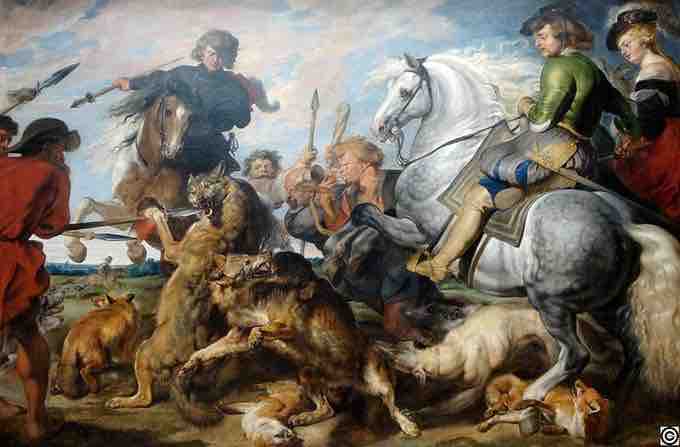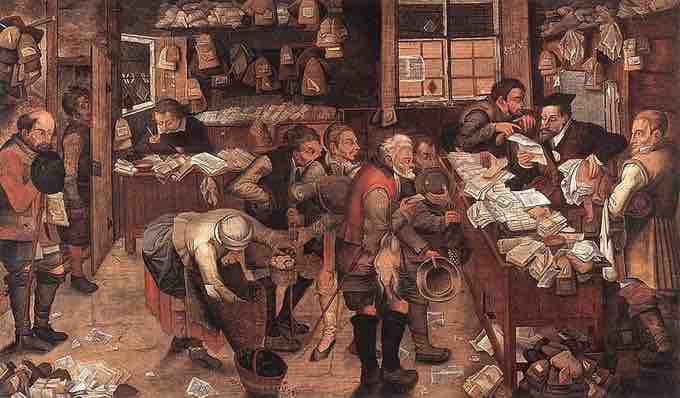Overview: Flemish Baroque
The style of painting produced in Flanders during the 17th century is known as Flemish Baroque. This style was produced between about 1585, when the Dutch Republic split from the Habsburg Spain regions of the south, until about 1700, when the Habsburg rule ended after the death of King Charles II. Antwerp—the home of Peter Paul Rubens, Anthony Van Dyck, and Jacob Jordaens—figured prominently as a point of artistic production during this time, as did Brussels and Ghent to a lesser extent. Peter Paul Rubens, the preeminent painter of the Flemish Baroque style, had a strong influence on the artistic aesthetic of the 17th century.
Categories of Flemish Painting
Flemish Baroque painting is notable for the fact that it was separated into different thematic categories, and artists of the time tended to specialize in one of these areas. These genres included history, portraiture, genre, landscape, and still life paintings.
History Painting
History painting, considered the most noble genre during the 17th century, was comprised of depictions of historical, biblical, mythological, and allegorical scenes. Peter Paul Rubens was the dominant painter in this category, though his student Anthony Van Dyck also became prominent. More than in any other category, Flemish history painters continued to draw influence from Italian painting. Rubens spent nine years in Italy studying the work of the masters, and he introduced the monumental hunting scene to painting. This is exemplified in his work Wolf and Fox Hunt, which depicts a noble battle on a large scale and was inspired by his study of classical antiquity.

Wolf and Fox Hunt by Peter Paul Rubens
Wolf and Fox Hunt is an example of the monumental hunting scene Rubens introduced to painting.
Portrait Paintings
Portrait paintings were, for the most part, monumental or life sized, though the group and family portrait came into prominence during the 17th century. Although he was not a portrait painter, Rubens completed some early works in this category. He also exerted influence through his student, Anthony Van Dyck, who became the court painter for Charles I of England and an influence on subsequent portraiture in England.
Genre Painting
Genre paintings depict scenes from everyday life and were very common in 17th century Flanders. These paintings feature figures with no specific identity, commonly engaged in activities associated with "the peasant life." Many genre artists follow the tradition of Peter Brueghel the Elder in their depiction of the lower classes. The paintings of Adriaen Brouwer, which often show peasants fighting and drinking, serve as an example of Flemish genre painting. Brouwer is known for painting his subjects in interior, rather than exterior, scenes. He was also known for his expressive facial studies, characteristic of a genre called "tronies" (faces) and exemplified in works such as The Bitter Drink.

Village Lawyer by Peter Brueghel
A genre painting by Peter Brueghel.
Landscapes
Landscape painting was another major category in the 17th century. The style developed from earlier 16th century Flemish landscape paintings, which were not particularly realistic and employed the semi-aerial view typical of Peter Brueghel the Elder. Architectural interior painting also became popular around this time, developing out of the works of Hans Vredman de Vries and depicting the realistic interiors of existing churches and cathedrals.
Still Lifes
Floral still life painting was widespread in 17th century Flanders, popularized by Brueghel the Elder around 1600. His sons, Jan Brueghel the Younger and Ambrosius Brueghel, were also known flower specialists of the time. Other subjects or subcategories of still life painting included the banquet still life, the animal still life, and garland scenes. Still life paintings often had an underlying moralistic message concerning the brevity of life, a trait exemplified by the "vanitas." A vanitas is a symbolic still life painting that is meant to illustrate the meaninglessness of earthly life and the transience of all earthly pursuits. Vanitas paintings were very popular in 17th century Flemish and Dutch work, and they often depict symbols such as skulls, flowers, rotting fruit, clocks, watches, smoke, and hourglasses, all of which are meant to convey the ephemeral nature of life on earth.

Vanitas Painting
An example of a vanitas from the 17th century by Franciscus Gysbrechts.